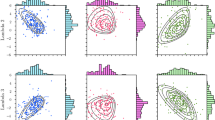Abstract
The specifications of state space model for some principal component-related models are described, including the independent-group common principal component (CPC) model, the dependent-group CPC model, and principal component-based multivariate analysis of variance. Some derivations are provided to show the equivalence of the state space approach and the existing Wishart-likelihood approach. For each model, a numeric example is used to illustrate the state space approach. In addition, a simulation study is conducted to evaluate the standard error estimates under the normality and nonnormality conditions. In order to cope with the nonnormality conditions, the robust standard errors are also computed. Finally, other possible applications of the state space approach are discussed at the end.


Similar content being viewed by others
Notes
The term “eigenvalue” used here (and frequently in Flury’s work) may not be the same as that in the traditional sense. In case \(K = 2\), it is possible that the eigenvalues subsumed by \({\varvec{\Lambda }}_{kk}\) may not be strictly ranked in descending order.
The block-diagonal matrix is obtained by permutation of columns of a parallel-diagonal matrix. Details of permutation can be found in Flury and Neuenschwander (1995).
For each square, but asymmetric, off-diagonal block \({\varvec{\Sigma }}_{kh} (k \ne h)\), such diagonalization requires two different orthogonal matrices, a process conceptually similar to singular value decomposition of an arbitrary square matrix. Because there are \(K(K - 1)/2\) unique off-diagonal blocks for the general cases, \(K(K - 1)\) orthogonal matrices are required.
References
Anderson, T. W. (2003). An introduction to multivariate statistical analysis (3rd ed.). New York: Wiley.
Bauer, D. J. (2003). Estimating multilevel linear models as structural equation models. Journal of Educational and Behavioral Statistics, 28, 135–167.
Bechger, T. M., Blanca, M. J., & Maris, G. (2014). The analysis of multivariate group differences using common principal components. Structural Equation Modeling, 21, 577–587.
Browne, M. W., & Shapiro, A. (1988). Robustness of normal theory methods in the analysis of linear latent variate models. British Journal of Mathematical and Statistical Psychology, 41, 193–208.
Caines, P. E., & Rissanen, J. (1974). Maximum likelihood estimation of parameters in multivariate Gaussian stochastic processes. IEEE Transactions on Information Theory, 20, 102–104.
Curran, P. J. (2003). Have multilevel models been structural equation models all along? Multivariate Behavioral Research, 38, 529–569.
Dolan, C. V. (1996). Principal component analysis using LISREL 8. Structural Equation Modeling, 2, 307–322.
Dolan, C. V., Bechger, T. M., & Molenaar, P. C. M. (1999). Using structural equation modeling to fit models incorporating principal components. Structural Equation Modeling, 6, 233–261.
Fleishman, A. I. (1978). A method for simulating non-normal distributions. Psychometrika, 43, 521–532.
Flury, B. N. (1984). Common principal components in k groups. Journal of the American Statistical Association, 79, 892–898.
Flury, B. N. (1986). Asymptotic theory for common principal component analysis. The Annals of Statistics, 14, 418–430.
Flury, B. N. (1987). Two generalizations of the common principal component model. Biometrika, 74, 59–69.
Flury, B. N. (1988). Common principal components and related multivariate models. New York: Wiley.
Flury, B. N., & Constantine, G. (1985). Algorithm AS 211: The F-G algorithm. Journal of the Royal Statistical Society Series C (Applied Statistics), 34, 177–183.
Flury, B. N., & Gautschi, W. (1986). An algorithm for simultaneous orthogonal transformation of several positive definite symmetric matrices to nearly diagonal form. SIAM Journal on Scientific and Statistical Computing, 7, 169–184.
Flury, B. D., & Neuenschwander, B. E. (1994). Simultaneous diagonalization algorithms with applications in multivariate statistics. In R. V. M. Zahar (Ed.), Approximation and computation: A Festschrift in honor of Walter Gautschi (pp. 179–205). Boston: Birkhäuser.
Flury, B. D., & Neuenschwander, B. E. (1995). Principal component models for patterned covariance matrices with application to canonical correlation analysis of several sets of variables. In W. J. Krzanowski (Ed.), Recent advances in descriptive multivariate analysis (pp. 90–112). New York: Oxford University Press.
Goria, M. N., & Flury, B. D. (1996). Common canonical variates in \(k\) independent groups. Journal of the American Statistical Association, 91, 1735–1742.
Gu, F., Preacher, K. J., Wu, W., & Yung, Y.-F. (2014). A computationally efficient state space approach to estimating multilevel regression models and multilevel confirmatory factor models. Multivariate Behavioral Research, 49, 119–129.
Hotelling, H. (1933). Analysis of a complex of statistical variables into principal components. Journal of Educational Psychology, 24, 417–441.
Huber, P. J. (1967). The behavior of maximum likelihood estimates under nonstandard conditions. Proceedings of the Fifth Berkeley Symposium on Mathematical Statistics and Probability, 1, 221–233.
Jones, R. H. (1993). Longitudinal data with serial correlation: A state-space approach. London: Chapman & Hall.
Kalman, R. E. (1960). A new approach to linear filtering and prediction problems. Transactions of the ASME-Journal of Basic Engineering (Series D), 82, 35–45.
Kiers, H. A. L., & ten Berg, J. M. F. (1989). Alternating least squares algorithms for simultaneous components analysis with equal component weight matrices in two or more populations. Psychometrika, 54, 467–473.
Kiers, H. A. L., & ten Berg, J. M. F. (1994). Hierarchical relations between methods for simultaneous component analysis and a technique for rotation to a simple simultaneous structure. British Journal of Mathematical and Statistical Psychology, 47, 109–126.
Neale, M. C., Hunter, M. D., Pritikin, J. N., Zahery, M., Brick, T. R., Kirkpatrick, R. M., & Boker, S. M. (2015). OpenMx 2.0: Extended structural equation and statistical modeling. Psychometrika. doi:10.1007/s11336-014-9435-8.
Neuenschwander, B. E. (1991). Common principal components for dependent random vectors. Unpublished doctoral dissertation. Switzerland: Department of Statistics, University of Berne.
Neuenschwander, B. E., & Flury, B. D. (1995). Common canonical variates. Biometrika, 82, 553–560.
Neuenschwander, B. E., & Flury, B. D. (2000). Common principal components for dependent random vectors. Journal of Multivariate Analysis, 75, 163–183.
Nevitt, J., & Hancock, G. R. (2001). Performance of bootstrapping approaches to model test statistics and parameter standard error estimation in structural equation modeling. Structural Equation Modeling, 8, 353–377.
Pearson, K. (1901). On lines and planes of closest fit to systems of points in space. Philosophical Magazine, 2, 559–572.
R Development Core Team. (2014). R: A language and environment for statistical computing. R Foundation for Statistical Computing, Vienna, Austria. http://www.R-project.org.
Schweppe, F. (1965). Evaluation of likelihood functions for Gaussian signals. IEEE Transactions on Information Theory, 11, 61–70.
Timmerman, M. E., & Kiers, H. A. L. (2003). Four simultaneous component models for the analysis of multivariate time series from more than one subject to model intraindividual and interindividual differences. Psychometrika, 68, 105–121.
Trendafilov, N. T. (2010). Stepwise estimation of common principal components. Computational Statistics and Data Analysis, 54, 3446–3457.
Yamada, T. (2008). The efficiency of the asymptotic expansion of the distribution of the canonical vector under nonnormality. Journal of The Japan Statistical Society, 38, 451–474.
White, H. (1980). A heteroscedasticity-consistent covariance matrix estimator and a direct test for heteroscedasticity. Econometrica, 48, 817–838.
Acknowledgments
The authors would like to thank Yiu-Fai Yung for his valuable comments and help with the programming in SAS/IML.
Author information
Authors and Affiliations
Corresponding author
Rights and permissions
About this article
Cite this article
Gu, F., Wu, H. Raw Data Maximum Likelihood Estimation for Common Principal Component Models: A State Space Approach. Psychometrika 81, 751–773 (2016). https://doi.org/10.1007/s11336-016-9504-2
Received:
Published:
Issue Date:
DOI: https://doi.org/10.1007/s11336-016-9504-2




